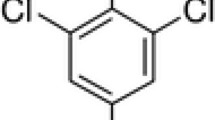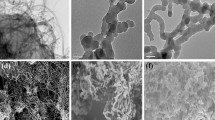Abstract
The authors describe an electrochemical method for the determination of herbicide 2,4-dichlorophenoxyacetic acid (2,4-D). It is based on the use of a molecularly imprinted polymer (MIP) and of dsDNA as a bio-specific substance. The modified electrode was prepared by electropolymerization of ortho-phenylenediamine (oPD) in the presence of DNA and of 2,4-D (the template). The imprinted MIP was placed on a pencil graphite electrode (PGE) modified with chitosan and multiwalled carbon nanotubes (MWCNTs). The template was removed with 0.4 M NaOH. The interaction of DNA with 2,4-D leads to its adsorption on the electrode, and this increases the sensitivity and selectivity of the method. After rebinding 2,4-D, the decrease in the peak current of oxidation of iron(II) acting as an electrochemical redox probe was measured by differential pulse voltammetry (DPV). The current, typically measured at around 0.5 V, increases linearly in the 0.01 to 10 pM 2,4-D concentration range, and the detection limit is 4.0 fM. The method is highly selective for 2,4-D. The modified electrode was applied to quantify 2,4-D in spiked environmental water and soil samples and gave absolute recoveries varying from 91.5 to 109.0%.

Schematic representation of the fabrication of an electrochemical sensor for determination of 2,4-dichlorophenoxyacetic acid (2,4-D). Initially, the electrode was modified with chitosan and MWCNTs and then a composite was formed on it consisting of ortho-phenylenediamine (oPD), DNA and 2,4-D.



Similar content being viewed by others
References
Maleki N, Safavi A, Shahbaazi H (2005) Electrochemical determination of 2, 4-D at a mercury electrode. Anal Chim Acta 530:69–74
Deng AP, Yang H (2007) A multichannel electrochemical detector coupled with an ELISA microtiter plate for the immunoassay of 2, 4-dichlorophenoxyacetic acid. Sensor Actuat B-Chem 124:202–208
Fontmorin JM, Huguet S, Fourcade F, Geneste F, Floner D, Amrane A (2012) Electrochemical oxidation of 2,4-Dichlorophenoxyacetic acid: analysis of by-products and improvement of the biodegradability. Chem Eng J 195-196:208–217
Kim GY, Shim J, Kang M-S, Moon SH (2008) Preparation of a highly sensitive enzyme electrode using gold nanoparticles for measurement of pesticides at the ppt level. J Environ Monit 10:632–637
Skládal P, Kaláb T (1995) A multichannel immunochemical sensor for determination of 2, 4-dichlorophenoxyacetic acid. Anal Chim Acta 316:73–78
Nomura Y, Muguruma H, Yano K, Kugimiya A, McNiven S, Ikebukuro K, Karube I (1998) Selective recognition of 2, 4-dichlorophenoxyacetic acid using a molecularly imprinted polymer. Anal Lett 31:973–980
Xie C, Gao S, Guo Q, Xu K (2010) Electrochemical sensor for 2, 4-dichlorophenoxy acetic acid using molecularly imprinted polypyrrole membrane as recognition element. Microchim Acta 169:145–152
Li H, Wang X, Wang Z, Wang Y, Dai J, Gao L, Wei M, Yan Y, Li C (2018) A polydopamine-based molecularly imprinted polymer on nanoparticles of type SiO2@rGO@Ag for the detection of lambda-cyhalothrin via SERS. Microchim Acta 185:193
Li S, Li J, Luo J, Xu Z, Ma X (2018) A microfluidic chip containing a molecularly imprinted polymer and a DNA aptamer for voltammetric determination of carbofuran. Microchim Acta 185:295
Roushani M, Nezhadali A, Jalilian Z (2018) An electrochemical chlorpyrifos aptasensor based on the use of a glassy carbon electrode modified with an electropolymerized aptamer-imprinted polymer and gold nanorods. Microchim Acta 185:551
Zargar T, Jafari MT, Khayamian T (2019) Molecularly imprinted graphite spray ionization-ion mobility spectrometry: application to trace analysis of the pesticide propoxur. Microchim Acta 186:396
Kong L, Jiang X, Zeng Y, Zhou T, Shi G (2013) Molecularly imprinted sensor based on electropolmerized poly (o-phenylenediamine) membranes at reduced graphene oxide modified electrode for imidacloprid determination. Sensor Actuat B-Chem 185:424–431
Wang Y, Han M, Ye X, Wu K, Wu T, Li C (2017) Voltammetric myoglobin sensor based on a glassy carbon electrode modified with a composite film consisting of carbon nanotubes and a molecularly imprinted polymerized ionic liquid. Microchim Acta 184:195–202
Alizadeh T, Ganjali MR, Zare M, Norouzi P (2010) Development of a voltammetric sensor based on a molecularly imprinted polymer (MIP) for caffeine measurement. Electrochim Acta 55:1568–1574
Andersson LI, Miyabayashi A, O'Shannessy DJ, Mosbach K (1990) Enantiomeric resolution of amino acid derivatives on molecularly imprinted polymers as monitored by potentiometric measurements. J Chromatogr A 516:323–331
Azadmehr F, Zarei K (2019) Fabrication of an imprinted electrochemical sensor from l-tyrosine, 3-methyl-4-nitrophenol and gold nanoparticles for quinine determination. Bioelectrochem 127:59–67
Kor K, Zarei K (2016) Development and characterization of an electrochemical sensor for furosemide detection based on electropolymerized molecularly imprinted polymer. Talanta 146:181–187
Zarei K, Ghorbani M (2019) Fabrication of a new ultrasensitive AuNPs-MIC-based sensor for electrochemical determination of streptomycin. Electrochim Acta 299:330–338
Akbari Hasanjani HR, Zarei K (2019) An electrochemical sensor for attomolar determination of mercury(II) using DNA/poly-L-methionine-gold nanoparticles/pencil graphite electrode. Biosens Bioelectron 128:1–8
Abolhasan R, Mehdizadeh A, Rashidi MR, Aghebati-Maleki L, Yousefi M (2019) Application of hairpin DNA-based biosensors with various signal amplification strategies in clinical diagnosis. Biosens Bioelectron 129:164–174
Jahanbakhshi M (2018) Myoglobin immobilized on mesoporous carbon foam in a hydrogel (selep) dispersant for voltammetric sensing of hydrogen peroxide. Microchim Acta 185:121
Ahmadi F, Bakhshandeh F (2009) In vitro study of damaging effects of 2, 4-dichlorophenoxyacetic acid on DNA structure by spectroscopic and voltammetric techniques. DNA Cell Biol 28:527–533
Rezaei B, Rahmanian O, Ensafi AA (2013) Sensing Lorazepam with a glassy carbon electrode coated with an electropolymerized-imprinted polymer modified with multiwalled carbon nanotubes and gold nanoparticles. Microchim Acta 180:33–39
Li J, Liu Q, Liu Y, Liu S, Yao S (2005) DNA biosensor based on chitosan film doped with carbon nanotubes. Anal Biochem 346:107–114
Zarei K, Teymori E, Kor K (2014) Very sensitive differential pulse adsorptive stripping voltammetric determination of 4-nitrophenol at poly (diphenylamine)/multi-walled carbon nanotube-β-cyclodextrin-modified glassy carbon electrode. Int J Environ Anal Chem 94:1407–1421
Losito I, Palmisano F, Zambonin PG (2003) o-Phenylenediamine electropolymerization by cyclic voltammetry combined with electrospray ionization-ion trap mass spectrometry. Anal Chem 75:4988–4995
Prabhakar N, Arora K, Singh SP, Singh H, Malhotra BD (2007) DNA entrapped polypyrrole–polyvinyl sulfonate film for application to electrochemical biosensor. Anal Biochem 366:71–79
Prabhakar N, Sumana G, Arora K, Singh H, Malhotra BD (2008) Improved electrochemical nucleic acid biosensor based on polyaniline-polyvinyl sulphonate. Electrochim Acta 53:4344–4350
Cai H, Cao X, Jiang Y, He P, Fang Y (2003) Carbon nanotube-enhanced electrochemical DNA biosensor for DNA hybridization detection. Anal Bioanal Chem 375:287–293
Zhang N, Xiao F, Bai J, Lai Y, Hou J, Xian Y, Jin L (2011) Label-free immunoassay for chloramphenicol based on hollow gold nanospheres/chitosan composite. Talanta 87:100–105
Long F, Shi H, He M, Zhu A (2008) Sensitive and rapid detection of 2, 4-dicholorophenoxyacetic acid in water samples by using evanescent wave all-fiber immunosensor. Biosens Bioelectron 23:1361–1366
Medyantseva EP, Vertlib MG, Kutyreva MP, Khaldeeva EI, Budnikov GK, Eremin SA (1997) The specific immunochemical detection of 2,4-dichlorophenoxyacetic acid and 2,4,5-trichlorophenoxyacetic acid pesticides by amperometric cholinesterase biosensors. Anal Chim Acta 347:71–78
Medyantseva EP, Vertlib MG, Budnikov GK, Babkina SS, Eremin SA (1995) Amperometric biochemical sensor based on immobi-lized cholinesterase in the immunoassay of pesticides. Zh Anal Khim 50:782–786
Navrátilová I, Skládal P (2004) The immunosensors for measurement of 2,4-dichlorophenoxyacetic acid based on electrochemical impedance spectroscopy. Bioelectrochem 62:11–18
Acknowledgements
The authors acknowledge the Research Council of Damghan University for partial support of this work.
Author information
Authors and Affiliations
Corresponding author
Ethics declarations
Conflict of interest
The authors have declared no conflict of interest.
Additional information
Publisher’s note
Springer Nature remains neutral with regard to jurisdictional claims in published maps and institutional affiliations.
Electronic supplementary material
ESM 1
(DOCX 1179 kb)
Rights and permissions
About this article
Cite this article
Azadmehr, F., Zarei, K. An imprinted polymeric matrix containing DNA for electrochemical sensing of 2,4–dichlorophenoxyacetic acid. Microchim Acta 186, 814 (2019). https://doi.org/10.1007/s00604-019-3980-x
Received:
Accepted:
Published:
DOI: https://doi.org/10.1007/s00604-019-3980-x




